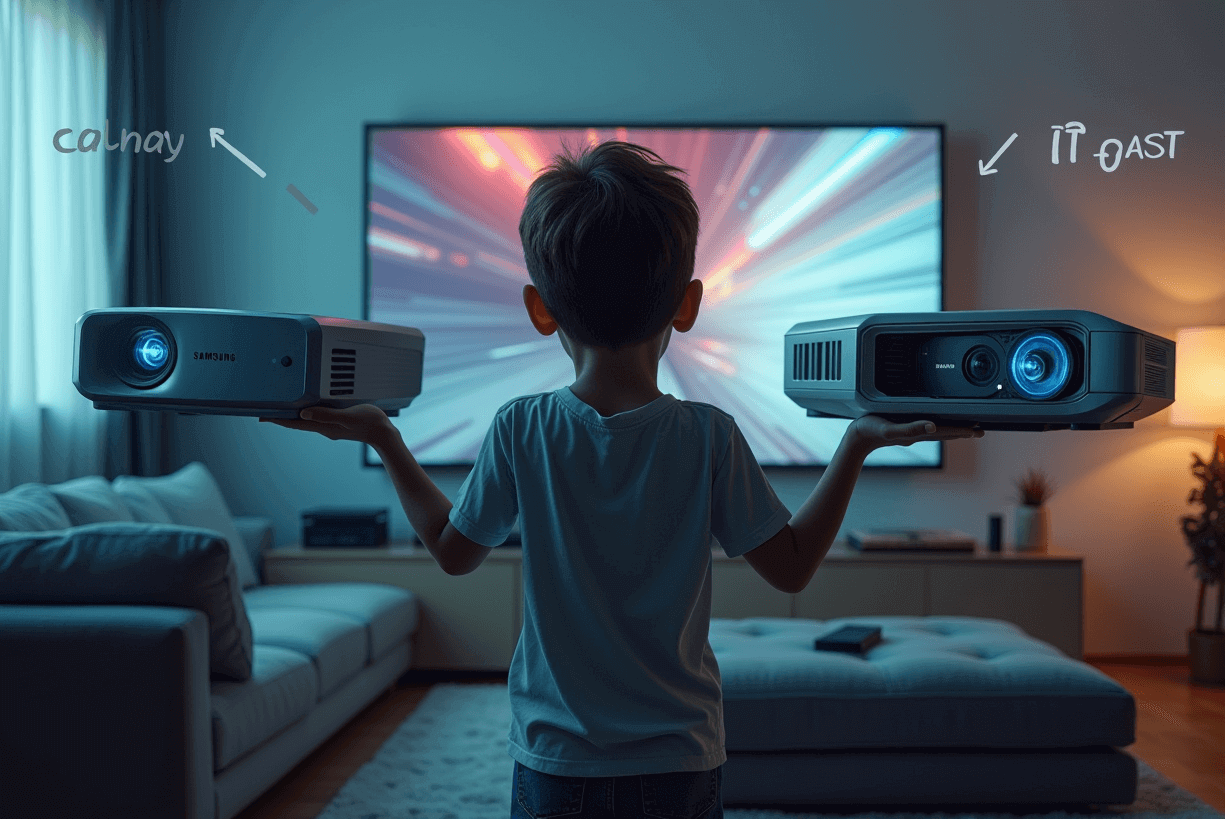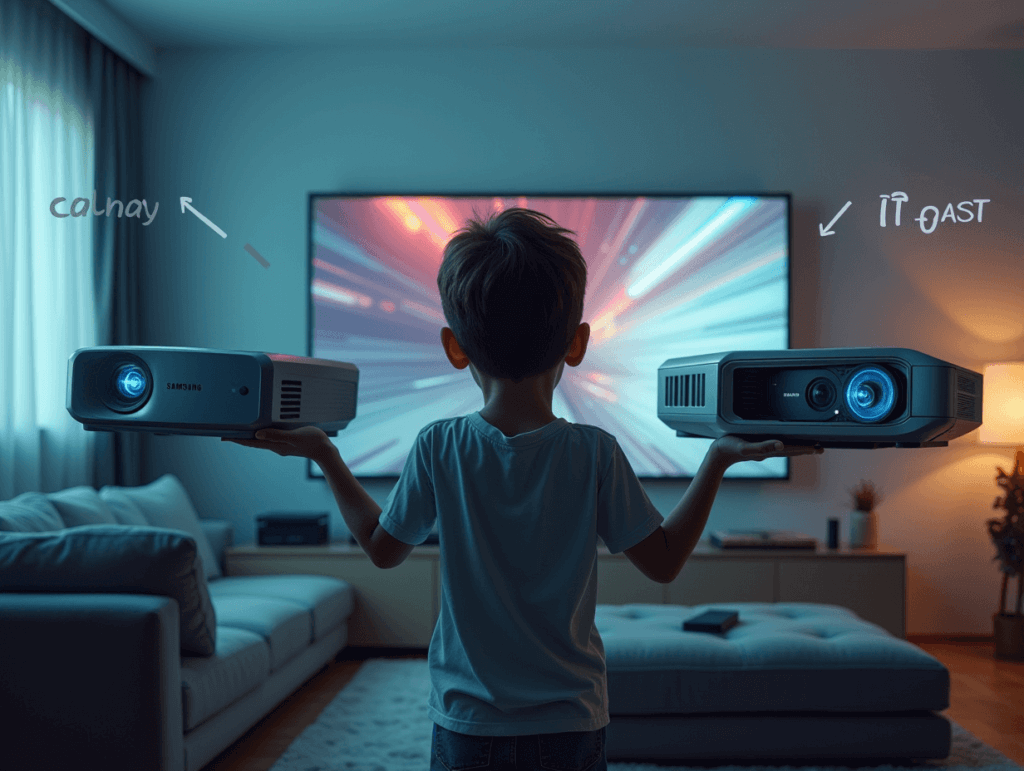



Samsung projectors aren’t for the faint of heart or the “good enough” crowd. If you’re fine with the same old boxy, mediocre projectors that struggle to give you a decent image in a dark room, keep moving. Samsung’s been flipping the script with laser tech, ultra-short throw, and all the wireless features that others are still trying to figure out. 4K? Sure, but don’t expect to get it unless you’re willing to pay the price of admission.
Their projectors are designed to make you wonder: Why did it take so long for someone to do this? A tiny footprint, packing a massive punch of clarity and color—yet, somehow, other brands are still stuck with the old school “just throw a projector up on the ceiling” strategy. Samsung’s throwing that out the window, with sleek designs that don’t need half your living room to work.
But let’s be real: the tech is impressive, but is it worth the premium? If you’re not into the idea of spending top dollar to ditch cables and actually have a modern home theater, then maybe Samsung’s not for you. But if you’re ready to leave those dusty projectors behind and embrace something a little bolder, Samsung’s ready to take you to the next level—if you can handle it.
Samsung’s early foray into projector technology wasn’t exactly subtle—it was more like a whirlwind entry. They didn’t just dip their toes into the pool; they cannonballed in with DLP (Digital Light Processing). Back in the day, when most projectors were struggling with blurry, dull images, Samsung saw an opportunity to light the way with sharper, brighter visuals. Suddenly, home projectors weren’t just for boardrooms—they were for movie nights and big-screen gaming.
In the early 2000s, when projectors were still bulky, heavy beasts, Samsung did the unthinkable: they made them more user-friendly. No more dealing with massive setups or half-blurry projections—Samsung gave the home theater crowd quality without the pain. While the competition was still perfecting their clunky CRT projectors, Samsung was quietly laying the groundwork for the sleek, efficient projectors that would eventually dominate the market.
And let’s not forget their push into LCD and LED technology, which further separated them from the competition. They weren’t satisfied with just offering a projector—they wanted a cinema experience. It was almost like they were building the future of home entertainment, one pixel at a time.
Samsung’s journey in the projector world has been nothing short of a plot twist in the tech story. The big first step? Entering the game with DLP technology in the early 2000s, a bold move that put them on the map. But they didn’t stop there. When others were content with standard home projectors, Samsung dove into the ultra-short-throw world, offering people the ability to create cinematic experiences in their living rooms without the hassle of long throw distances. It was as if they looked at projector setups and said, “Let’s make it simpler, smarter, and cooler.”
The real kicker? Their shift to laser projectors. While other brands were still toying with bulbs and standard LED, Samsung threw down the gauntlet with laser-based models that delivered brighter, sharper images. The Premiere LSP9T wasn’t just another projector—it was the beginning of a whole new way of thinking about what home entertainment could be. And as they pushed forward, they didn’t just innovate—they began shaping a trend that would force the competition to level up.
Looking ahead, Samsung’s milestones might include integrating AI-driven image enhancements or even pushing the limits with quantum dot technology. So, yeah, their history is full of “Remember when?” moments. And the best part? The next chapter hasn’t even been written yet.
Samsung’s projectors aren’t just keeping up with innovation—they’re leading the charge. Take their triple-laser technology—this isn’t some gimmick; it’s a game-changer. The color accuracy is so rich, it might make you wonder if they’ve somehow added a sprinkle of magic to the tech. Forget washed-out images; this is a new standard in projector color brilliance, forcing other brands to reconsider their approach to visual quality.
Then there’s the ultra-short-throw revolution. Samsung doesn’t care about the old-school notion of projectors needing a ton of space. With a few feet of room, you can throw a 130-inch screen onto your wall. It’s like Samsung looked at everyone’s cramped living rooms and said, “Challenge accepted.”
Their AI-powered auto-focus and room calibration is another leap forward. Gone are the days of fiddling with manual settings—now, the projector does all the thinking for you. And let’s not forget about smart features—Samsung has made projectors more connected, with built-in streaming apps and voice control, making it clear that they’re gunning for the “smart home” crown, not just the cinema throne.
Add all of this to their wireless streaming capabilities, and it’s obvious: Samsung isn’t just innovating—they’re inventing the future of home entertainment. The question isn’t if others will catch up, but whether they even can.
Samsung has turned the home entertainment game on its head. With laser projectors that rival high-end TVs in color and clarity, they’ve made the idea of a “home theater” more accessible—and way cooler. Forget the days of bulky projectors that required a separate room and a night vision goggle for clarity. Now, anyone with a wall and a decent budget can enjoy theater-quality visuals from the comfort of their couch.
Their push into ultra-short-throw technology has been a game changer, giving rise to projectors that don’t need miles of space between you and the screen. Need proof? The Premiere LSP9T—set it up a few feet from the wall, and you’ve got a 130-inch screen. Suddenly, your living room is no longer just for Netflix—it’s a full-blown cinema.
Samsung’s projectors have also brought cinema to the portable generation, offering flexibility that traditional home theater setups can’t touch. Want to turn your backyard into a movie theater? No problem. Take it on vacation and project movies on a hotel wall? Easy. These moves have forced other brands to get smarter, faster, and lean harder into wireless streaming and “smart” features, creating a competitive frenzy that only benefits consumers.
Samsung didn’t just enter the home entertainment market—they redefined it, pushing the limits of what we thought possible in a living room. And in the process, they’ve made other brands look like they’re still stuck in the DVD era.
Samsung’s current projector lineup is like a tech lover’s dream buffet. The Premiere LSP9T bursts onto the scene with its triple-laser technology, delivering colors so vibrant they might make your TV jealous. It’s built for cinephiles who want nothing less than a 4K, 130-inch wall of jaw-dropping visuals. Not to be overshadowed, The LSP7T might lack the triple-laser flash, but it still flexes impressive 4K resolution and ultra-short-throw power, perfect for squeezing a big-screen experience into any living room.
For those who crave portability, The Freestyle tosses tradition aside. It’s lightweight, flexible, and even fits in a backpack, ready to turn any wall or ceiling into an instant movie theater. Samsung’s quirky twist? The Freestyle also functions as a smart speaker and ambient light, practically begging for a spot in the “cool gadgets” listicles.
Each model has a personality: powerhouse, versatile, or ultra-portable. Samsung’s projectors aim to cover all tastes—even if it sometimes feels like they’re throwing every feature at the wall to see what sticks.
Looking ahead, Samsung’s projectors are likely to get smarter, sleeker, and even more futuristic—think AI-powered visuals that adjust to your environment without lifting a finger. Imagine a projector that scans the room, fine-tunes the brightness, and optimizes color balance, all while you’re busy binge-watching your favorite series. The days of manual adjustments? Gone.
Expect higher portability—Samsung seems obsessed with turning any space into a cinematic experience, whether it’s your living room, backyard, or hotel room. Their future projectors might shrink even further, but pack larger-than-life performance. Wireless streaming will likely go through the roof, ditching those annoying cables once and for all.
And here’s a spicy guess: Quantum Dot technology could be making its way into projectors sooner than expected, bringing the kind of picture quality that makes OLED look like yesterday’s tech. Will Samsung continue to push the boundaries of the “home theater experience”? You bet. Will we see projectors that double as smart home hubs or voice assistants? It’s not just possible—it’s probably in the pipeline.
In short, Samsung’s future projectors are likely to be more powerful, smarter, and let’s face it—way cooler than ever before. They’re not just keeping up with trends—they’re setting them.